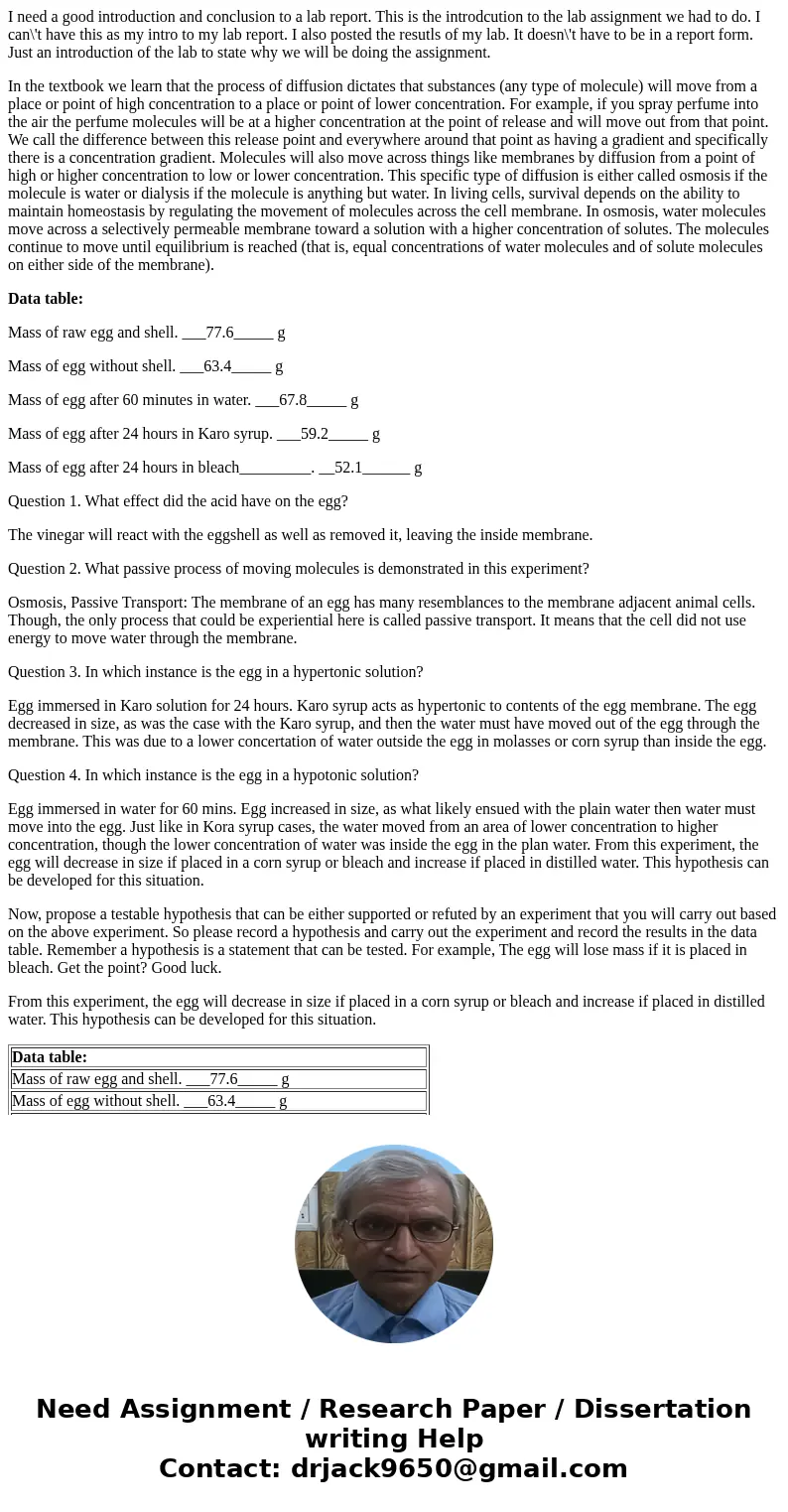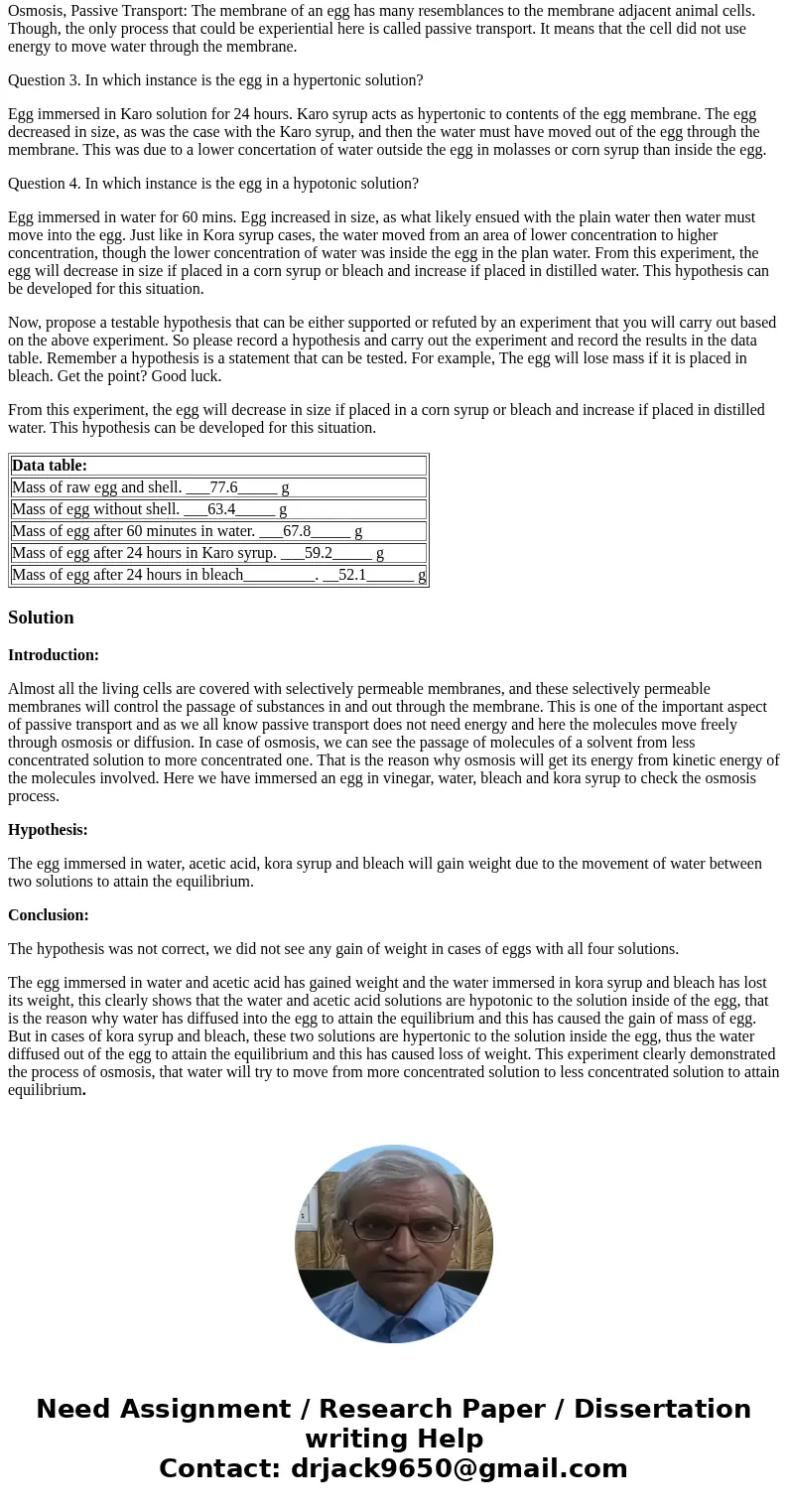I need a good introduction and conclusion to a lab report Th
I need a good introduction and conclusion to a lab report. This is the introdcution to the lab assignment we had to do. I can\'t have this as my intro to my lab report. I also posted the resutls of my lab. It doesn\'t have to be in a report form. Just an introduction of the lab to state why we will be doing the assignment.
In the textbook we learn that the process of diffusion dictates that substances (any type of molecule) will move from a place or point of high concentration to a place or point of lower concentration. For example, if you spray perfume into the air the perfume molecules will be at a higher concentration at the point of release and will move out from that point. We call the difference between this release point and everywhere around that point as having a gradient and specifically there is a concentration gradient. Molecules will also move across things like membranes by diffusion from a point of high or higher concentration to low or lower concentration. This specific type of diffusion is either called osmosis if the molecule is water or dialysis if the molecule is anything but water. In living cells, survival depends on the ability to maintain homeostasis by regulating the movement of molecules across the cell membrane. In osmosis, water molecules move across a selectively permeable membrane toward a solution with a higher concentration of solutes. The molecules continue to move until equilibrium is reached (that is, equal concentrations of water molecules and of solute molecules on either side of the membrane).
Data table:
Mass of raw egg and shell. ___77.6_____ g
Mass of egg without shell. ___63.4_____ g
Mass of egg after 60 minutes in water. ___67.8_____ g
Mass of egg after 24 hours in Karo syrup. ___59.2_____ g
Mass of egg after 24 hours in bleach_________. __52.1______ g
Question 1. What effect did the acid have on the egg?
The vinegar will react with the eggshell as well as removed it, leaving the inside membrane.
Question 2. What passive process of moving molecules is demonstrated in this experiment?
Osmosis, Passive Transport: The membrane of an egg has many resemblances to the membrane adjacent animal cells. Though, the only process that could be experiential here is called passive transport. It means that the cell did not use energy to move water through the membrane.
Question 3. In which instance is the egg in a hypertonic solution?
Egg immersed in Karo solution for 24 hours. Karo syrup acts as hypertonic to contents of the egg membrane. The egg decreased in size, as was the case with the Karo syrup, and then the water must have moved out of the egg through the membrane. This was due to a lower concertation of water outside the egg in molasses or corn syrup than inside the egg.
Question 4. In which instance is the egg in a hypotonic solution?
Egg immersed in water for 60 mins. Egg increased in size, as what likely ensued with the plain water then water must move into the egg. Just like in Kora syrup cases, the water moved from an area of lower concentration to higher concentration, though the lower concentration of water was inside the egg in the plan water. From this experiment, the egg will decrease in size if placed in a corn syrup or bleach and increase if placed in distilled water. This hypothesis can be developed for this situation.
Now, propose a testable hypothesis that can be either supported or refuted by an experiment that you will carry out based on the above experiment. So please record a hypothesis and carry out the experiment and record the results in the data table. Remember a hypothesis is a statement that can be tested. For example, The egg will lose mass if it is placed in bleach. Get the point? Good luck.
From this experiment, the egg will decrease in size if placed in a corn syrup or bleach and increase if placed in distilled water. This hypothesis can be developed for this situation.
| Data table: |
| Mass of raw egg and shell. ___77.6_____ g |
| Mass of egg without shell. ___63.4_____ g |
| Mass of egg after 60 minutes in water. ___67.8_____ g |
| Mass of egg after 24 hours in Karo syrup. ___59.2_____ g |
| Mass of egg after 24 hours in bleach_________. __52.1______ g |
Solution
Introduction:
Almost all the living cells are covered with selectively permeable membranes, and these selectively permeable membranes will control the passage of substances in and out through the membrane. This is one of the important aspect of passive transport and as we all know passive transport does not need energy and here the molecules move freely through osmosis or diffusion. In case of osmosis, we can see the passage of molecules of a solvent from less concentrated solution to more concentrated one. That is the reason why osmosis will get its energy from kinetic energy of the molecules involved. Here we have immersed an egg in vinegar, water, bleach and kora syrup to check the osmosis process.
Hypothesis:
The egg immersed in water, acetic acid, kora syrup and bleach will gain weight due to the movement of water between two solutions to attain the equilibrium.
Conclusion:
The hypothesis was not correct, we did not see any gain of weight in cases of eggs with all four solutions.
The egg immersed in water and acetic acid has gained weight and the water immersed in kora syrup and bleach has lost its weight, this clearly shows that the water and acetic acid solutions are hypotonic to the solution inside of the egg, that is the reason why water has diffused into the egg to attain the equilibrium and this has caused the gain of mass of egg. But in cases of kora syrup and bleach, these two solutions are hypertonic to the solution inside the egg, thus the water diffused out of the egg to attain the equilibrium and this has caused loss of weight. This experiment clearly demonstrated the process of osmosis, that water will try to move from more concentrated solution to less concentrated solution to attain equilibrium.


 Homework Sourse
Homework Sourse